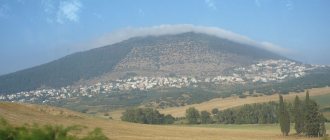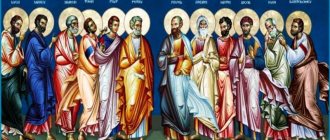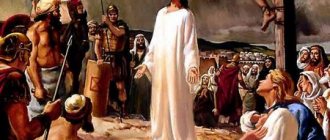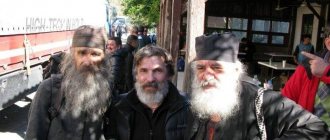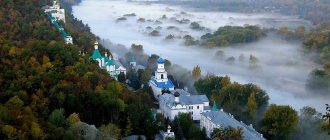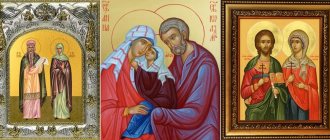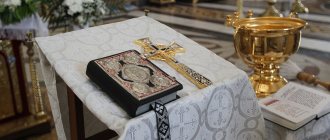Favor and Deborah
Mount Tabor (Tabor) is located in Galilee, 11 km southwest of the Sea of Galilee, 9 km from Nazareth.
This is a free-standing mountain in the middle of the beautiful Jezreel Valley with a height of 588 meters. Tabor has been considered a holy place since the Old Testament. When they wanted to present something sublime and majestic, they took Mount Tabor for comparison.
It was here that a battle took place that united several tribes of Israel, led by the prophetess and warrior Deborah. (And this is far from the only case in the history of the Israelis when women became warriors and leaders of their people).
“The Lord God of Israel commands: Go, go up to Mount Tabor , and take with you ten thousand men from the children of Naphtali and the children of Zebulun; “And I will bring Sisera, the captain of Jabin, and his chariots to you, to the brook Kishon, and his chariots, and I will deliver him into your hands,” so said Deborah to the captain of the army Barak (Judges 4: 6-7).
Where is
Mount Tabor, or as they say in Hebrew, Tabor, is located towards the east of the central part of the Izdrelon Valley, in Israel. Just nine kilometers southeast of it is Nazareth, and the Sea of Galilee stretches twice as far to the west.
Mount Tabor is not part of any mountain range or range, but is a separate hill. Compared to others, it is quite low - 588 meters. The slopes here are gentle, and the shape has soft and slightly rounded outlines. Therefore, in many sources the Hebrew name Tavor is translated as “navel”, drawing an analogy with the human organ.
Mountain high
Pilgrims at Mount Tabor.
Drawing from the mid-19th century from the site wikimedia.org It is interesting that in the text of the Gospel itself there is no mention of Tabor as the place of the Transfiguration of the Lord. Matthew and Mark speak only of this event, mentioning a “high mountain.”
“And after six days Jesus took Peter, James, and John his brother, and led them up a high mountain alone, and was transfigured before them: and His face shone like the sun, and His clothes became white as light.” (Matthew 17:1-2)
Evangelist Luke speaks simply of “mountain.”
The tradition of considering Mount Tabor as the site of the Transfiguration of the Lord is associated with the holy Queen Helen (IV). She builds a basilica on the highest point of Tabor in honor of the Transfiguration of the Savior, and a little lower - a temple where the apostles Peter, James and John were during the Transfiguration, whom the Lord called with Him to the mountain.
At the Fifth Ecumenical Council (VI) it was decided to form a bishopric here. They built a large monastery, surrounded by a wall, and a hospice house. The monks, together with the bishop, did not leave Tabor even during the Saracen raids.
Pilgrims have been going to Tabor since the 4th century. By the 9th century, a staircase was built - 4340 steps.
Mentions in the Old Testament
The fact that this is a special place was said back in ancient times - before the birth of Christ. For the first time it is said about Tabor that this is a special place where the lands of the three tribes of Israel came together.
You can also find other references that remained in the books of the Old Testament: Joshua, the prophecies of Jeremiah. For a long time, if they talked about the significance and importance of a person, they compared him with how majestically Mount Tabor rises.
Israel today is a modern state, but despite this, it carefully and reverently preserves its history, which has become the property of all mankind.
"The host of Latin monks and our Nazarenes"
Catholic monastery on the top of Tabor.
Photo from wikipedia.org In the 12th century, the Crusaders came to the Holy Land and built new temples there. By this time, the Christian Church had already been divided into Orthodox and Catholic, but the division had not yet affected the lives of believers.
Latin monks often hid Orthodox monks during raids by Arab tribes - their walls were higher, and their monasteries looked like fortresses.
In 1177, the Greek pilgrim John Phocas leaves interesting details (written in true Byzantine style) about the structures on Mount Tabor, describing the Latin and Orthodox Greek monasteries at the very top of the mountain, emphasizing that the site of the Transfiguration itself is in the hands of the “Latins.”
“Mount Tabor, the earthly sky, the joy of the soul and the delight of the eyes of Orthodox people. For this mountain is characterized by a certain divine grace that overshadows it, and that is why it arouses spiritual joy. It is a round and moderately elevated hill. At its top there are two monasteries, in which Christian hermits propitiate the Deity with multilingual chants, and
on that part of it on which the saving Transfiguration of Christ took place, there is a host of Latin monks, and on the right side our Nazarenes are consecrating the consecrated place.
For the saving Transfiguration of Christ took place on the top of that hill on which the Latin monastery is located, and in the altar of its temple is the very place on which the Lord was transfigured among Elijah, Moses and his three chosen disciples Peter, John and James. This place is fenced with copper bars.
And at the point where the Lord’s feet stood, an extremely white marble circle is visible, in the middle of which is an image of a cross. The indescribable fragrance flowing from it delights the senses of those who come.
Outside the monastery, at a distance of about a stone’s throw, there is a small cave into which Christ, having entered after the terrible Transfiguration, commanded his disciples not to tell anyone about the vision until he rose from the dead.”
Up ▲ — Reader reviews (3) — Write a review ▼ — Print version
| e-mail, city: Moscow | |
Tell us about the cross! Which my mother, Anna Ilyinichna, donated to the museum. By the way, caught by me in the Psel River, at the base of the fagor!
| Ilya | 12 October 2012, 20:21:49 |
| city: kazakhstan | |
| Elena | 14 May 2013, 18:16:11 |
| e-mail, city: Sudzha-Moscow | |
According to what version of UNESCO? give a link to the UNESCO list where you can see this place.
Massacre of Christians on Tabor
Mount Tabor.
Mid-19th century drawing from wikimedia.org In the 12th century, the Arab leader Salah ad-Din attacked the Greek Orthodox monastery on Tabor. The Orthodox monks were sheltered by the Latin brothers in their monastery.
This monastery held out until the Crusaders were defeated in a battle with the Muslims in 1187. Salah ad-Din's troops beat up the Christians living on Tabor and drove out all the monks from there. In 1212, on the top of Mount Tabor, Muslims built a powerful fortress to repel the attacks of the crusaders.
In 1263, Muslims settled in the Holy Land, and all the fortifications, all buildings on Mount Tabor were destroyed, from that moment Mount Tabor became uninhabited for several centuries. Only on the feast of the Transfiguration of the Lord did Orthodox and Catholics rise here to perform divine services.
Ancient history
Scientists are still arguing about the origin of the name of the mountain. According to the main version, the word “Tavor” comes from the Hebrew word “Tavor”, meaning “navel”, a clear allusion to the shape and isolated location of the hill. Mount Tabor went down in history long before Christian times. The fact is that it was located next to the most important trade route from Egypt to Mesopotamia through Damascus. Whoever owned this commanding height controlled the Great Sea Route. It is not surprising that there was a constant struggle for Favor.
One of the sad pages of the Jewish people is connected with the mountain. During the Jewish Wars, fleeing the Roman legions, Galilean Jews under the leadership of Josephus created powerful fortifications on the mountain with impressive walls and deep ditches. The Romans were unable to subdue the defenders of Tabor by force, tripled the multi-day siege, and then promised to pardon the defenders if they laid down their arms. The thirsty warriors agreed, but were deceived and, as a warning to other opponents of the Empire, they were cruelly executed - crucifixion along the road leading from Tabor.
Dispute over a holy place
Mount Tabor.
Late 17th century engraving from wikimedia.org By the 14th century, the authentic site of the Transfiguration of the Lord was already causing controversy. The Orthodox considered the authentic place in their monastery, the Catholics - in theirs. The head of the Russian Spiritual Mission in Jerusalem, Archimandrite Porfiry (Uspensky), discussed this.
“Each religion assigns to its monastery the area where the Savior was transfigured. I do not confirm or deny either one or the other legend. It is enough for a Christian to believe that the Lord was transfigured on the elevation of Tabor, and to pray to Him for the enlightenment of the soul and eternal salvation.
And the event took place not on one yard of land, but on the entire mountain. The light was visible from a distance; the voice was heard far away; the cloud overshadowed the whole mountain; a voice from heaven was heard throughout the mountain. So the whole top of the mountain is sacred.”
What does the name mean
Historians give several versions. The name Tavor, or, as they say in the Russian-speaking tradition, Favor, is not translated and is given in the Old Testament in the same way. However, there is a version that says that the name Tavor is derived from the word “Tabur”. The latter is translated as “navel.” This version is confirmed by the characteristic external features of a detached mountain with gentle slopes and a somewhat concave peak, which is Mount Tabor.
There is another option. Its author is Teresa Petroczi. She claims that the modern name is a derivative of the name of the pagan deity Tabor, who patronized blacksmithing in these places in pre-Jewish (Canaanite) times. And the traces of paganism of this period found by archaeologists in some way confirm the assumption.
“Only the venerable hermit now stands guard over the shrine.”
Mount Tabor.
Drawing from the mid-19th century from the site wikimedia.org From the mid-19th century, monks began to come to Tabor again. The revival of the Orthodox monastery on Tabor began with the Moldavian archimandrite Irinarch, a student of the famous Paisius Velichkovsky, who, together with his friend Hierodeacon Nestor, settled here in a cave, in the ruins of an old temple.
Irinarch and Nestor found among a pile of stones the remains of an ancient temple with semicircular niches. Having set up an altar there, the elders began to serve prayers for the pilgrims who came here.
Pilgrims, whose number began to increase every day, donated for the construction of the temple. Patriarch Kirill II of Jerusalem also helped, sending 5,000 piastres for construction and ordering the Jerusalem Patriarchate to help the elder as needed.
But there was not enough money, so I had to turn for help to Bishop Kirill of Melitopol, head of the Russian Spiritual Mission in Jerusalem, who personally knew the 90-year-old Irinarch well. He addressed the Chairman of the Palestine Committee, Grand Duke Konstantin Nikolaevich, with a memo:
"St. Favor, sealed by the great evangelical event, but now unfortunately forgotten and left unattended by the local Orthodox authorities, while the Latins are already prowling around him, trying to take him as prey.
The shrine is now guarded only by a venerable hermit, a ninety-year-old elder originally from the Slavs, who came to Tabor as a result of a vision he had, settled here and with his own hands discovered the ruins and restored the ancient church.
Without the help of the Greeks, despite the opposition of the Latins, among the Bedouin gangs (who, however, have religious reverence for him as a miracle worker), this wondrous old man had already made a good start, using benefits only from our side. The temple builder is now asking for 30 thousand piastres (about 1,500 rubles in gray) to complete the building he started.”
Elder Irinarchus did not live to see the completion of the temple and its consecration. He died on Christmas Day, December 25, 1859; the temple was being completed by his friend Nestor.
On August 6, 1862 (on the day of the Transfiguration according to the Old Style), Patriarch Kirill II of Jerusalem arrived at Tabor and solemnly consecrated the new temple - in the name of the Transfiguration of the Lord.
How to get there?
The easiest way to get to Favor is by personal or rented car, which can be rented in any major city. The main thing is to do this on a weekday, since rental companies may not work on Saturday and Sunday. Regular buses to these places go poorly and inconveniently: they either pass near the mountain at night or stop too far from it. You can get there from Tiberias or Nazareth by taxi for a reasonable price.
The best option for most vacationers is group excursions with a guide, which are arranged by travel agencies from major Israeli cities. The excursion can be booked in advance on the Internet by selecting the desired date and time, at the same time it will be possible to learn the trip program in detail and better prepare for it.
Due to the narrow road, the route to Tabor is closed to buses; they drop off passengers at the foot of the mountain. Then you can use minibuses and taxis with Arab drivers or make the ascent on foot. There are two walking routes, 5 and 3 kilometers long. Both are rich in amazing views and wonderful nature.
Transfiguration Service on the night of August 18-19
Aerial photograph of Mount Tabor.
Photo from 2013 from wikimedia.org Today, on the top of Mount Tabor there are two active monasteries: the Orthodox Greek convent of the Transfiguration of the Lord in the northeastern part of the peak, and the Catholic Franciscan monastery.
Every year, on the feast of the Transfiguration of the Lord, on the night of August 18-19, according to the new style, Orthodox pilgrims from all over the world arrive at the Holy Mount Tabor. Here the Jerusalem Patriarchate holds a solemn festive service - not in the temple itself, but in front of the entrance on a specially constructed platform with an altar, since the temple is not able to accommodate everyone.
Many believers testify to the miraculous Tabor cloud descending on the Orthodox monastery after the Liturgy. Christians see this as a sign of God’s special grace.
Catholic Church
Appeared here at the end of the 19th century. It is located on the territory where in the 13th century there was a fortress built by Muslims. Also preserved here are the ruins of a temple of Latin monks, the ruins of a monastery from Byzantine times and other sacred places that Mount Tabor hides. The Temple of the Transfiguration is the greatest architectural discovery of Antonio Barluzzi.
The artist created a basilica here that is stunning in its beauty. It bears the name of a miraculous event - the Transfiguration of the Lord. The road leading to the temple reveals ancient ruins to pilgrims - evidence of past eras, which Mount Tabor has preserved to this day.
The Church of the Transfiguration has two towers that divide the entrance to the basilica into two parts and are located above the ancient chapels. One is named after the prophet Moses, and the second is named after Elijah. From this place the huge temple building begins, leading to the main place - the altar. Parishioners are led here by descending marble steps, which reveal an ancient place - the ruins of a Byzantine basilica that was previously located here.
